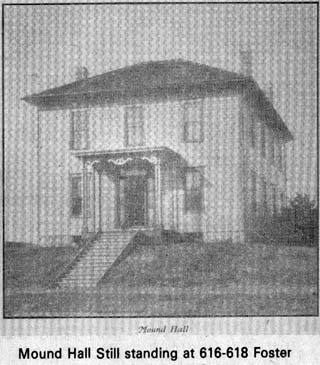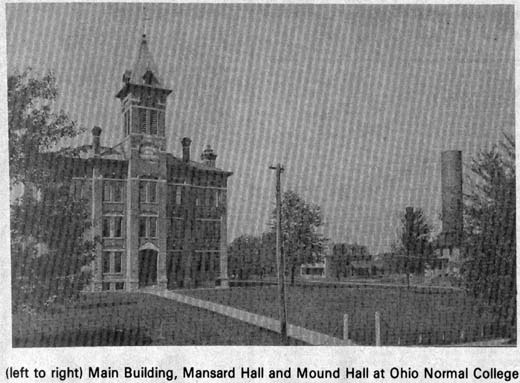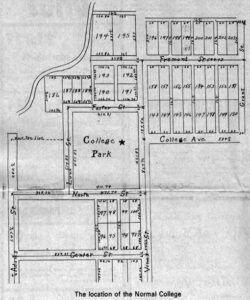June 15, 1978



Picture #1 – (Left to right) Main Building, Mansard Hall and Mound Hall at Ohio Normal College
Picture #2 – Mound Hall still standing at 616-618 Foster
Picture #3 – The location of the Normal College (map)
Last year when I wrote about Fostoria’s public school system, I was reminded of the higher educational institutions that once were here, and about which many local and area readers are unaware.
Before, and at the turn of the century, Fostoria had outstripped neighboring towns in educational facilities, and it is the story about the start, the progress and fall of those schools that I write today.
As I put together this story, I considered the importance of colleges to a community. Had Fostoria’s survived, it would be of great value for our young people today and for the city in general.
CIVIL WAR KILLED FIRST SCHOOL
Prior to the Civil War, Rev. William A. Turner, minister of the First Presbyterian Church conducted a “Select” school for boys of high school age. When the Civil War occurred Turner enlisted, as did most of the boys in his school. Turner survived the war but did not return to the church, so the school did not reopen. A group of Fostoria businessmen immediately set to work to see what they could do to get a school of higher learning for this community.
N.W. NORMAL SCHOOL
At that time, 1870, the Northwestern Normal and Training School was in operation at Republic, Ohio. Historical records are not specific, but apparently the local businessmen who were behind the movement to establish a school here convinced authorities of the school at Republic to move to Fostoria.
In 1874, according to data in The History of Seneca County, N.W. Normal moved to Fostoria. J.F. Richard who was principal of the school while at Republic, along with one or two teachers also continued their association.
Just where the school was conducted, the records do not indicate…perhaps in the Union School building located on North Main at Fremont streets, or on the upper floors of a business block on Main Street. It may have been in the building on the southwest corner of Main and North because when I was a boy I remember the sign painted on the North Street side of that building, reading FOSTORIA BUSINESS COLLEGE.
508 ENROLLED
According to a catalog of the school published in 1875, progress had been made and the school had grown to the extent that in addition to the N.W. Normal and Training School, it also had a branch called the Fostoria business College. The combined institutions had a staff of 14 people to manage and instruct the 508 students enrolled. According to the catalog (copy on file at Kaubisch Library) students came from all over Ohio, also Kentucky, Pennsylvania, California, Kansas and Michigan.
Subjects taught were: English grammar, teaching, natural sciences, ancient languages, mathematics, science, rhetoric. algebra, penmanship, drawing, piano, organ and vocal music.
SCHOOL FAILED
According to historical records, due to financial mismanagement the school failed…perhaps late in 1875.
Immediately, an association was formed for establishing another school. On November 6, 1875, articles of incorporation were signed by a group of men consisting of Michael Beilger, A.J. Longfellow, Fred Manecke, J.L. Kenower, J.A. Bradner, John E. Wilkison, Amos S. Williams, Leigh Harbaugh.
Apparently, between Nov. 1875 and July 1876 this group of men wrestled with the problem of how to get the necessary money to establish the new school. Evidently they had information and a good reason, because in July 1876, an expanded group of citizens petitioned the Findlay Conference of the United Brethren Church to establish a school here. The group of citizens consisted of: Isaac Crouse, J.S. Overholt, John A. Bradner, Thorton D. Ingle, Joseph Stouffer, C. Olmsted, W.J. Rigby, Roswell Crocker, O.J. DeWolfe, Junius V. Jones, Isaac Warner, Jesse Bower, Charles Foster, L.J. Hissong, C.W. Foster, J.W. Bricker, M.D.
FOSTORIA ACADEMY
September of 1876, the Sandusky Conference of the United Brethren Church granted the petition, with the agreement that the people of Fostoria would raise funds to purchase land and erect buildings.
A board of trustees was appointed, consisting of M. Bulger, D.R. Miller, A. Powell, T.J. Harbaugh, A. Rose, I. Crouse, Charles Foster, Levi Adams, Jesse Bower, J. Burgner, W.J. Andres and Dr. William Detwiler.
Twenty-two thousand dollars was raised by Fostorians for building. Four acres of land was donated by Charles Foster for the site. And so the program for the new school of higher learning…to become known as The Fostoria Academy…was on its way.
Historical records indicate that Foster also built the two dormitories on the land and initially rented them to the school. foster’s plan was apparently to later donate the dormitory buildings to the school, but the records do not definitely so state.
The cornerstone of the new academy was laid August 14, 1879. It was located on the land donated by Foster…to become known as College Square…and at the end of the street to be named College Ave.
The first principal of the new academy was Professor W.T. Jackson. Upon his resignation in 1884, several others followed him in filling that position.
The academy was an important factor in the intellectual and moral uplift of Fostoria, stated an early report.
FAILED AND REORGANIZED
Just how long the academy continued operating successfully the records do not show, but eventually it became evident that the students low tuition fees, coupled with the small amount the United Brethren Church had raised to support it were not sufficient and it was forced to close. A catalog published by the academy at its inception show term rates, including board and tuition, with room in Gentlemen’s Hall $38 to $41. Same in Ladies Hall $42.
The catalog advertised the academy as…”A Christian Institution of Learning. ..Experienced Instructors…Preparing for the Sophomore Year of the Best Ohio College”. It offered courses for teaching, ancient and modern languages, science, commercial, instrumental and voice music, penmanship.
Records at my disposal do not indicate, but eventually Professor W.E. Ashcraft of Indiana and a group of associates, purchased the property and reopened it, naming it Ohio Normal College.
With the new leadership the school prospered and grew. A catalog published by Ohio Normal College in 1903 showed an enrollment of over 500 in the various courses consisting of preparatory, teachers, scientific, psychology and pedagogy, music, commercial, shorthand and typewriting.
Students were enrolled from all over Ohio as well as 16 other states and Canada.
DESTROYED BY FIRE
In 1904, a fire caused by an overheated furnace burned the Ohio Normal College to the ground, and it was never rebuilt. The only remains to remind Fostorians of the college is the women’s dormitory, which was remodeled into apartments, and still stands on Foster street.
The residence of Professor W.E. Ashcraft still stands on West Fremont Street. It is the large brick property on the south side of the street, west of Vine, near the old water tower.
All Fostorians, but particularly those living in the west part of town will be interested in the accompanying surveyor’s sketch, showing the College Park area and the adjacent streets. The star in the park area shows the approximate location of the building which was originally the Academy and later Ohio Normal College.
The extension of College Avenue came about after the school burned down and was later demolished. Lunt, Foster and Adams streets in the west part of Fostoria were named after persons who owned land in that area during the early days…Charles W. Foster, Laura Foster, Phila Lunt and Jonathon Adams.
The land in that area, 169 area, had earlier been purchased by John Gorsuch, and deeded to him in papers from the U.S. Land Office and signed by President Andrew Jackson.